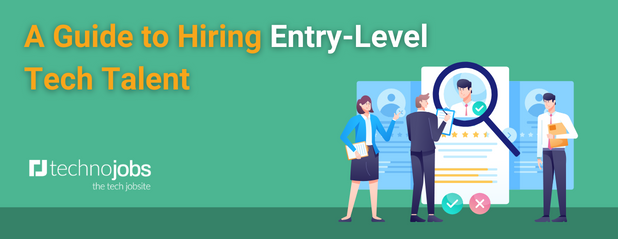A Guide to Hiring Entry-Level Tech Talent

Companies across industries are constantly seeking skilled individuals to join their teams and drive innovation. However, finding and hiring entry-level tech talent can be a daunting task. With so many candidates to choose from, it's crucial to have a solid hiring strategy in place.
In this guide, we will explore the key steps and best practices for hiring entry-level tech talent. From defining your hiring needs to conducting effective interviews, we've got you covered.
Understanding Your Hiring Needs
Before diving into the hiring process, it's essential to have a clear understanding of your company's specific hiring needs. Start by identifying the skills and qualifications required for the entry-level tech position you are looking to fill.
Consider the specific technologies, programming languages, and tools that are relevant to the role. Additionally, think about the cultural fit and soft skills that are important for your team. By defining your hiring needs upfront, you can streamline the rest of the hiring process and attract the right candidates.
Crafting an Attractive Job Description
A well-crafted job description is crucial for attracting top talent. It should provide a clear overview of the role, responsibilities, and qualifications required. Use concise and engaging language to highlight the exciting aspects of the position and your company.
Be specific about the technologies and skills required, but also emphasise opportunities for growth and learning. Additionally, consider including information about your company culture and any unique perks or benefits. Remember to optimise your job description with relevant keywords to improve its visibility in search engines.
Sourcing Tech Candidates
Once you have a compelling job description, it's time to start sourcing candidates. There are various channels you can use to attract entry-level tech talent. Here are a few effective strategies:
- Post your job opening on popular job boards and tech-specific platforms such as Technojobs.
- Leverage social media platforms like LinkedIn, Twitter, and Facebook to reach a wider audience.
- Attend job fairs and tech events to connect with potential candidates.
- Utilise your professional network and ask for referrals from colleagues and industry contacts.
- Consider partnering with coding bootcamps and tech-focused educational institutions.
By using a combination of these strategies, you can cast a wide net and attract a diverse pool of candidates.
Screening and Assessing Tech Candidates
Once you start receiving applications, it's time to screen and assess the candidates. This step is crucial for narrowing down the pool and identifying the most qualified individuals. Consider implementing the following strategies:
- Review CVs and cover letters to assess candidates' skills and experience.
- Conduct phone or video interviews to further evaluate candidates' qualifications and cultural fit.
- Administer technical assessments or coding challenges to assess candidates' technical abilities.
- Check references to verify candidates' past performance and work ethic.
By implementing a thorough screening and assessment process, you can ensure that only the most qualified candidates move forward in the hiring process.
Conducting Effective Interviews
Interviews are a critical part of the hiring process. They provide an opportunity to assess candidates' skills, cultural fit, and overall suitability for the role. To conduct effective interviews, consider the following tips:
- Prepare a list of structured interview questions that cover both technical and behavioural aspects.
- Utilise behavioural interviewing techniques to assess candidates' problem-solving skills and past experiences.
- Include practical coding exercises or whiteboard sessions to evaluate candidates' technical abilities.
- Involve multiple interviewers to gain different perspectives and reduce bias.
- Provide candidates with an opportunity to ask questions and learn more about your company.
By conducting well-planned and structured interviews, you can gather valuable insights and make informed hiring decisions.
Making the Final Decision
After conducting interviews and assessing candidates, it's time to make the final decision. Consider the following factors:
- Evaluate candidates based on their technical skills, cultural fit, and potential for growth.
- Consider the overall team dynamics and how the candidate will contribute to the team's success.
- Consult with key stakeholders and involve other team members in the decision-making process.
- Communicate the decision to the selected candidate promptly and professionally.
- Provide feedback to all candidates, even those who were not selected.
By considering these factors and involving key stakeholders, you can make a confident and informed hiring decision.
Onboarding and Retaining Talent
Once you have hired an entry-level tech talent, it's essential to have a robust onboarding and retention strategy in place. Effective onboarding ensures that new hires feel welcomed and supported, while retention strategies help keep them engaged and motivated. Here are some tips for successful onboarding and retention:
- Provide a comprehensive orientation program that introduces new hires to the company culture, values, and processes.
- Assign a mentor or buddy to guide and support new hires during their initial days.
- Offer ongoing training and development opportunities to help new hires grow their skills.
- Foster a positive and inclusive work environment that encourages collaboration and innovation.
- Recognise and reward achievements to motivate and retain top talent.
- Conduct regular check-ins and performance evaluations to provide feedback and address any concerns.
- Provide opportunities for career advancement and growth within the company.
By investing in effective onboarding and retention strategies, you can maximize the potential of your entry-level tech talent and create a positive work environment.
Hiring entry-level tech talent can be a challenging process, but with the right strategies and approach, you can find the right candidates to drive your company's success.
By understanding your hiring needs, crafting attractive job descriptions, sourcing candidates effectively, screening and assessing candidates thoroughly, conducting effective interviews, making informed decisions, and implementing strong onboarding and retention strategies, you can build a talented and diverse tech team. Remember to continuously adapt and refine your hiring process to stay competitive in the tech industry.




